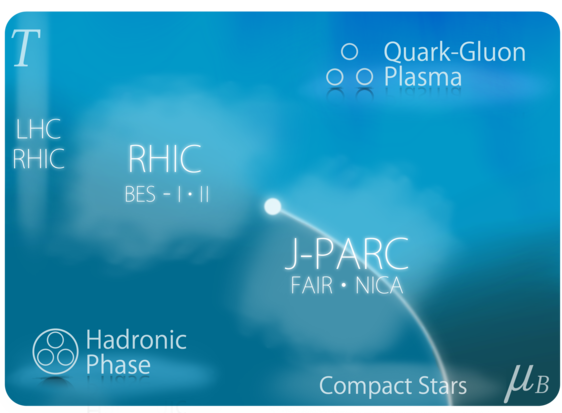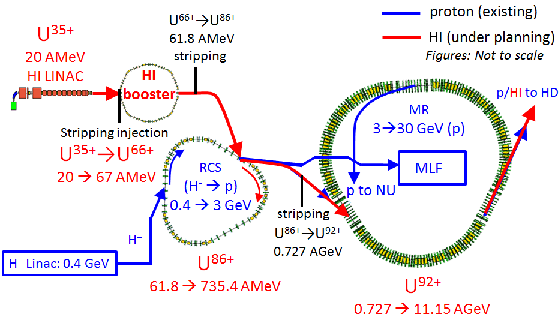Overview
we propose a new physics program with heavy-ion beams at J-PARC (Japan Proton Accelerator Research Complex). In this program, J-PARC-HI, we will accelerate heavy ions by the MR (Main Ring synchrotron) at J-PARC and perform fixed-target experiments with high collision rates. The medium with baryon number density several times higher than the normal nuclear density is expected to be created in this experiment. The main physics objectives of this program are to determine the QCD (Quantum Chromodynamics) phase structure on the temperature (T) and baryon chemical potential (μB) plane, and to study the properties of extremely dense matter realized in neutron stars.It is predicted theoretically that the phase diagram of QCD on the T-μB plane has a first-order phase boundary and a critical point as shown in Fig.1 while their locations and properties are not yet well determined. Therefore, one of the major goals of this program is to find these phase structures experimentally. Although the creation of the quark-gluon plasma (QGP) has been established in high-energy heavy-ion collisions at RHIC (Relativistic Heavy Ion Collider) and the LHC (Large Hadron Collider), the medium created by these experiments is limited to small μB region at which the transition to the QGP is a smooth crossover. The medium with large μB can be probed with heavy-ion collisions at lower collision energies. Because the beam energy which will be realized in J-PARC is suitable for the creation of dense medium, this program will open an opportunity for revealing the phase structure at large μB with precise experimental data.
Another important physics at high baryon density is to determine the equation of state of nuclear matter relevant to neutron stars and neutron star mergers. Recently, the study of the EoS in the core of neutron stars has been stimulated by the observation of neutron stars with a mass of about twice the solar mass. The equation of state of the hot and dense medium also acquires much attention as it will be studied by the gravitational wave emitted from neutron star mergers. The heavy-ion collisions at the J-PARC energy can produce matter at similar density and temperature in neutron star mergers. This program thus will be a unique experiment to study the EoS under extreme environments created by neutron star mergers and possibly in the core of neutron stars on the earth.
At present, only protons can be accelerated at J-PARC. By adding heavy-ion beams to J-PARC, we can open new and rich research fields. Experiments which have been performed at J-PARC Hadron Experimental Facility with proton and secondary meson beams include studies of lepton pairs, hypernuclei, exotic hadrons, baryon-baryon interactions and so on. These experiments are aimed at studying hadron and nuclear properties at a similar or a lower density to the normal nuclear density. With heavy-ion collisions, we will extend these physics to higher baryon density.
There are other several on-going or planned heavy-ion programs around the J-PARC energies in the world such as RHIC, NICA (Nuclotron-based Ion Collider fAсility) and FAIR (Facility for Antiproton and Ion Research). The collision energy range of RHIC is higher than that of J-PARC, while the range of NICA is slightly lower. These experiments will be complementary to J-PARC. J-PARC has a similar energy range to FAIR with the SIS-100 synchrotron, and both will have extremely high interaction rates. J-PARC would have advantage over FAIR with the SIS-100 due to a higher maximum energy and higher beam rates.

Fig.1 A schematic QCD phase diagram in the temperature (T)
We propose a heavy-ion acceleration scheme at J-PARC, with a new heavy-ion injector consisting of a linac and a booster synchrotron whereas we use the existing RCS (Rapid-Cycling Synchrotron) and the MR as shown in Fig.~\ref{HI-Scheme}.
The heaviest ions which can be accelerated are Uranium ions with the highest energy of 20 AGeV.
The high-intensity performance of the RCS and the MR which has been already established by proton acceleration would enable acceleration of world's highest intensity heavy-ion beams of 4×1011 in a MR cycle.
We will operate proton beams for the MLF (Material and Life sciences Facility) and heavy-ion beams for the MR in parallel with the RCS.
The heavy-ion beams from the MR are slowly extracted and transported to the Hadron Experimental Facility via the high-momentum beam line.

Fig.2 A possible heavy-ion acceleration scheme to adopt in the existing J-PARC facilities
At J-PARC, we search for the QCD critical point by measuring event-by-event fluctuations of conserved charges such as the baryon number, the electric charge, and strangeness, and search for the chiral symmetry restoration by measuring dileptons and charmed mesons.
We measure collective flow and correlations to study the equation of state of dense matter and search for the critical point and a phase transition.
We also measure multi-strangeness hadrons, hypernuclei with the strangeness (S) with |S|≥2, and search for strange quark matter (strangelets). These measurements become possible by taking advantage of the high collision rate at J-PARC.
In order to realize these variety of physics, we are planning to construct a large acceptance spectrometer for lepton, photon, and hadron measurements. The spectrometer consists of forward and barrel silicon vertex trackers around the target, a ring-imaging Cherenkov detector, 12-fold toroidal coils which form the magnetic field along the φ-direction, time-of-flight counters, electro-magnetic calorimeters, neutron counters, and the muon trackers system. GEM (Gaseous Electron Multiplier) trackers enable precise track reconstruction.
We are going to submit a letter of intent for this program to J-PARC Program Advisory Committee in 2016, and thenmake a budget plan by 2018 to meet the budget proposal for 2019. We aim to start the first heavy-ion experiment in 2024.
